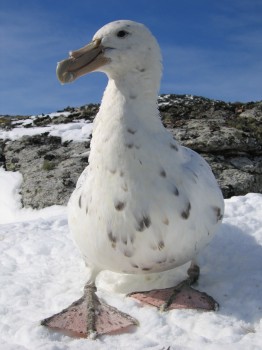Lucas Krüger (Marine and Environmental Sciences Centre, University of Coimbra, Portugal) and colleagues have published in the journal Antarctic Science on gender differences in distribution of non-breeding Southern Giant Petrels Macronectes giganteus tracked from the South Shetland Islands.
The paper’s abstract follows:
“Literature reports that body size can be associated with latitudinal distribution, for instance larger animals inhabit higher latitudes and colder habitats. This rule can be applied for species and populations within a species. The potential influence of body size on non-breeding distribution and habitat use at the intra-population level was investigated for southern giant petrels Macronectes giganteus (Gmelin) from Elephant Island, South Shetland Islands. The non-breeding distribution of 23 individuals was tracked, and total body length, culmen length, wing length, wing load and body mass were measured. Positions of core areas were used to estimate the latitudinal distribution of each individual. Smaller individuals were found to be associated more with lower latitudes, where warmer conditions and more coastal and productive waters prevail, whereas large males were associated more with higher latitudes, with colder conditions near sea ice caps, presumably feeding on carrion or preying on penguins. This association reflects a latitudinal gradient, with smaller individuals positioning themselves towards the north, and larger individuals towards the south. In this case, body size, individual distribution and habitat use were found to be associated, highlighting the importance of studying potential effects of individual body size on the ecology of seabirds.”

White-phase Southern Giant Petrel on the snow, photograph by Michael Dunn
Reference:
Krüger, L., Paiva, V.H., Finger, J,V.G. & Petersen, E. 2018. Intra-population variability of the non-breeding distribution of southern giant petrels Macronectes giganteus is mediated by individual body size. Antarctic Science 30: 271-277.
John Cooper, ACAP Information Officer, 23 August 2019

 English
English  Français
Français  Español
Español